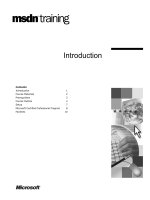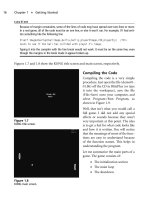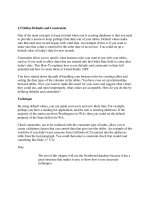Tài liệu Socket Programming and Multithreading pptx
Bạn đang xem bản rút gọn của tài liệu. Xem và tải ngay bản đầy đủ của tài liệu tại đây (86.11 KB, 15 trang )
Socket Programming and Multithreading
The DNS Server project
The purpose of this lesson is to show you how you can do socket programming in C#.
Network programming in windows is possible with sockets. A socket is like a handle to a
file. Socket programming resembles the file IO as does the Serial Communication. You
can use sockets programming to have two applications communicate with each other. The
two applications are typically on different computers but they can be on the same
computer. For the two applications to talk to each other on the same or different
computers using sockets, one application is generally a server that keeps listening to the
incoming requests and the other application acts as a client and makes the connection to
the server application. The server application can either accept or reject the connection. If
the server accepts the connection, a dialog can begin with between the client and the
server. Once the client is done with whatever it needs to do, it can close the connection
with the server. Connections are expensive in the sense that servers allow finite
connections to occur. During the time the client has an active connection; it can send the
data to the server and/or receive the data.
The complexity begins here. When either side (client or server) sends data the other side
is supposed to read the data. But how will the other side know when data has arrived.
There are two options - either the application needs to poll for the data at regular intervals
or there needs to be some sort of mechanism that would enable application to get
notifications for the application to read the data at that time. Well, Windows is an event
driven system and the notification system seems an obvious and best choice here.
So, the two applications that need to communicate with each other need to make a
connection first. In order for the two applications to make connections, the two
applications need to identify each other (or each other's computer). Computers on
network have a unique identifier called IP address which is represented in dot-notation
like 10.20.120.127, etc. Lets see how all this works in .NET.
1- The Server
a. Implement the GUI shown below (call your project DNServer):
b. Include the following using statements:
• using System.Net
• using System.Net.Sockets
• using System.Collections
•
using System.Threading
•
using System.IO
c. declare the following variables, objects, and resources:
• public delegate void UpdateRichEditCallback(string
text);
•
public AsyncCallback functionWorkerCallBack;
• private Socket myMainSocket;
• private System.Collections.ArrayList
myWorkerSocketList = ArrayList.Synchronized(new
System.Collections.ArrayList());
•
private int myClientCount = 0;
•
private int myCurrentClientsCount = 0;
d.
name= richActivity
name= txtIP
name= txtPort
name= buttonStart
name= buttonStop
name= txtClients
name= buttonClear
name= buttonClose
IP address returned
from GetIP() method
which is called from
the Form constructor
GetIP( )
e.
Constructor
f. Test it!
g. Our socket communication will follow the following steps.
1) Create a socket
2) Bind the socket to an address or end point
3) Listen for an incoming communications attempt
4) Accept the communication
5) Send and receive messages (packets)
6) Shutdown the communication channel
7) Close the socket connection
String GetIP()
{
String strHostName = Dns.GetHostName();
// Find host by name
IPHostEntry iphostentry = Dns.GetHostByName(strHostName);
// Grab the first IP addresses
String IPStr = "";
foreach(IPAddress ipaddress in iphostentry.AddressList)
{
IPStr = ipaddress.ToString();
return IPStr;
}
return IPStr;
}
public DNServer()
{
// The InitializeComponent() call is required for Windows
Forms designer support.
InitializeComponent();
// Display the local IP address on the GUI
txtIP.Text = GetIP();
}
try
{
// Check the port value
if(txtPort.Text == "")
{
MessageBox.Show("Please specify a Port Number");
return;
}
string portStr = txtPort.Text;
int port = System.Convert.ToInt32(portStr);
// Create the listening socket...
myMainSocket = new Socket(AddressFamily.InterNetwork,
SocketType.Stream, ProtocolType.Tcp);
IPEndPoint ipLocal = new IPEndPoint (IPAddress.Any, port);
// Bind to local IP Address...
myMainSocket.Bind( ipLocal );
// Start listening (waiting queue size = 4)...
myMainSocket.Listen(4);
// Create the call back for any client connections...
myMainSocket.BeginAccept(new AsyncCallback (OnClientConnect),
null);
buttonStart.Enabled = false;
buttonStop.Enabled = true;
}
catch(SocketException se)
{
MessageBox.Show ( se.Message );
}
buttonStart_Click( )
• SocketType.Stream: we would use reliable two way connection-based
sockets. The other choice is to use unreliable connection-less sockets
(SocketType.Dgram)
• IPEndPoint: A class under System.Net namespace which represents a
network computer as an IP address and a port number. The IPEndPoint
has two constructors - one that takes an IP Address and Port number and
one that takes a long address and port number. Since we have computer IP
address we would use the former.
h. Implement the call back function, which will be invoked when a client is
connected
public void OnClientConnect(IAsyncResult asyn)
{
try
{
// End the Asynchronous connection. This would
// returns the reference to a new Socket object
Socket workerSocket = myMainSocket.EndAccept (asyn);
// Now increment the client count for this client
// in a thread safe manner
Interlocked.Increment(ref myClientCount);
Interlocked.Increment(ref myCurrentClientsCount);
// Add the workerSocket reference to our ArrayList
myWorkerSocketList.Add(workerSocket);
//Show current number of clients on the GUI
txtClients.Text = myCurrentClientsCount.ToString();
// Send a welcome message to client
string msg = "Welcome client" + myClientCount + "\n";
SendMsgToClient(msg, myClientCount);
string foo = "Client" + myClientCount + " Connected" + "\n";
AppendToActivityRichBox(foo);
// Let the worker Socket do the further processing for the
// just connected client
WaitForData(workerSocket, myClientCount);
// Since the main Socket is now free, it can go back and wait for
// other clients who are attempting to connect
myMainSocket.BeginAccept(new AsyncCallback ( OnClientConnect ),null);
}
catch(ObjectDisposedException)
{
System.Diagnostics.Debugger.Log(0,"1","\n OnClientConnection: Socket
has been closed\n");
}
catch(SocketException se)
{
MessageBox.Show ( se.Message );
}
}
i. Implement the method that sends the message to the other side:
void SendMsgToClient(string msg, int clientNumber)
{
// Convert the reply to byte array
byte[] byData = System.Text.Encoding.ASCII.GetBytes(msg);
Socket workerSocket = (Socket)myWorkerSocketList[clientNumber - 1];
workerSocket.Send(byData);
}
private void AppendToActivityRichBox(string msg)
{
// Check to see if this method is called from a thread
// other than the one created the control
if (InvokeRequired)
{
// We cannot update the GUI on this thread.
// All GUI controls are to be updated by the main (GUI) thread.
// Hence we will use the invoke method on the control which will
// be called when the Main thread is free
// Do UI update on UI thread
object[] pList = {msg};
richActivity.BeginInvoke(new UpdateRichEditCallback(OnUpdateRichEdit),
pList);
}
else
{
// This is the main thread which created this control, hence update it
// directly
OnUpdateRichEdit(msg);
}
}
private void OnUpdateRichEdit(string msg)
{
richActivity.AppendText(msg);
richActivity.Focus();
richActivity.ScrollToCaret();
}
SendMsgToClient( )
j. Implement the method that updates the RichTextBox which should be a
thread safe method since it could be called by either the main thread or
any of the worker threads:
k. The method that Start waiting for data from the client









